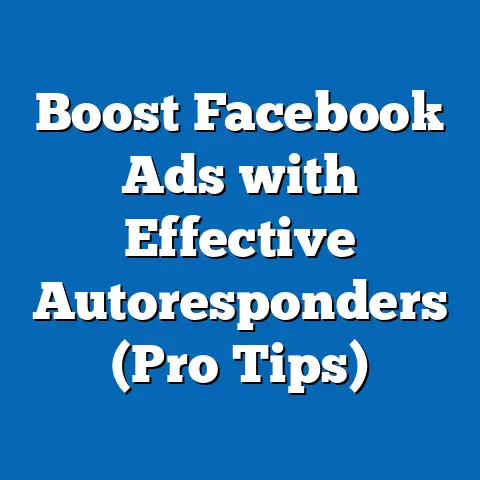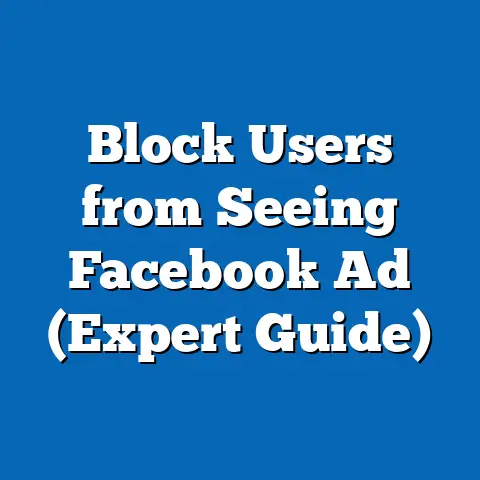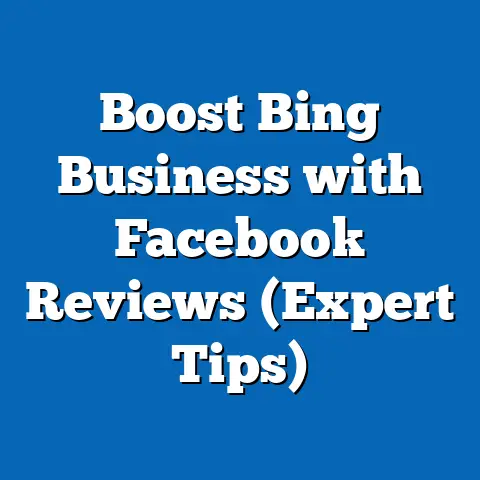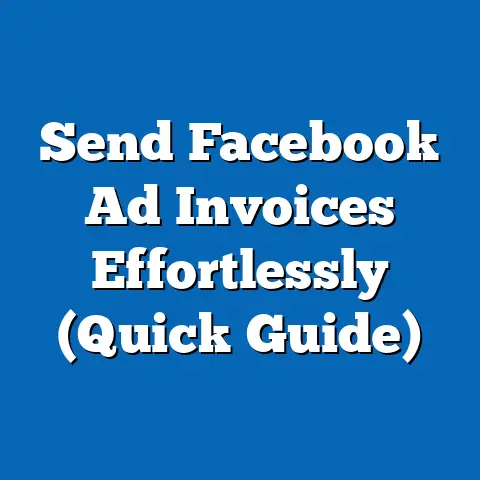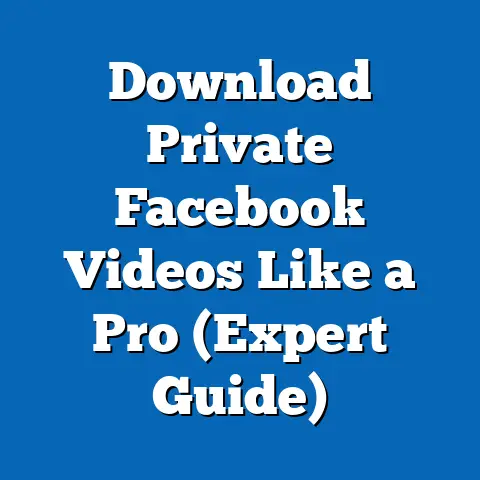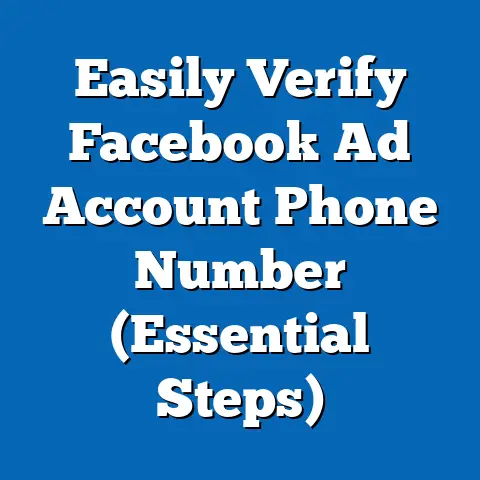Maximize Consultant Facebook Ads for ROI (Proven Strategies)
Crafting effective Facebook ads is an art. It’s not just about a flashy visual or a catchy slogan. It requires a deep understanding of your target audience, precise messaging, and a strategic approach to campaign management. In the consulting niche, where expertise and trust are paramount, a well-executed Facebook ad campaign can significantly boost your ROI. I’ve seen firsthand how consultants who master this platform can transform their lead generation and client acquisition. This isn’t about throwing money at the problem; it’s about strategic investment.
In this guide, I’m going to walk you through proven strategies consultants can implement to maximize their ROI through Facebook ads. We’ll dive into audience understanding, crafting compelling copy, designing eye-catching visuals, leveraging different ad formats, implementing smart targeting, and, crucially, analyzing and adjusting your campaigns for optimal performance. Let’s get started!
Understanding Your Audience: The Foundation of ROI
Before you spend a single dollar on Facebook ads, you need to know who you’re talking to. Audience research is the cornerstone of maximizing ROI. Think of it like this: you wouldn’t build a house without a blueprint, right? Similarly, you shouldn’t run Facebook ads without a solid understanding of your ideal client.
A consultant must identify their ideal client profiles. This includes demographics (age, location, income), interests (professional networks, industry publications), and, most importantly, their pain points. What problems are your potential clients facing? What keeps them up at night? How can your consulting services alleviate their challenges?
Tools and Methods for Audience Research
Here are a few tools and methods I recommend for conducting thorough audience research:
- Facebook Audience Insights: This free tool within Facebook Ads Manager is a goldmine of information. It allows you to analyze the demographics, interests, and behaviors of people on Facebook, both in general and those connected to your Page. I’ve used it countless times to uncover hidden interests and refine my targeting.
- Surveys: Don’t underestimate the power of direct feedback! Create a short survey using tools like SurveyMonkey or Google Forms to gather insights from your existing clients or potential leads. Ask questions about their challenges, goals, and what they look for in a consultant.
- Competitor Analysis: See what your competitors are doing on Facebook. Who are they targeting? What kind of messaging are they using? This can provide valuable clues about the market landscape.
- Client Interviews: Talk to your current clients! Ask them about their journey to finding you, their expectations, and what they value most about your services.
Real-World Examples
I remember working with a business strategy consultant who initially targeted a broad audience of “small business owners.” After digging into Audience Insights, we discovered that their ideal clients were actually owners of restaurants specifically struggling with menu optimization and marketing. By narrowing their targeting and crafting ad copy that spoke directly to these pain points, they saw a 3x increase in lead generation.
Another consultant I advised focused on leadership development. Initially, their ads were generic, talking about “improving leadership skills.” Through surveys, they learned that their target audience was primarily female executives who felt undervalued and overlooked in their organizations. They then tailored their ads to address these specific concerns, resulting in a significantly higher click-through rate and conversion rate.
Takeaway: Don’t guess! Invest time and effort in understanding your audience. The more you know about their needs, desires, and pain points, the more effectively you can target your ads and craft compelling messaging.
Crafting Compelling Ad Copy: Speak Directly to Their Needs
Once you understand your audience, you need to speak their language. Compelling ad copy is crucial for capturing attention and driving action. It’s not enough to simply list your services; you need to articulate the unique benefits you offer and connect with potential clients on an emotional level.
The Elements of Effective Ad Copy
- Clear Value Proposition: What makes your consulting services different? What specific results can clients expect? Be clear, concise, and focus on the benefits, not just the features. Instead of saying “We offer strategic planning,” say “We help you create a roadmap to double your revenue in the next year.”
- Emotional Storytelling: People connect with stories. Share a brief anecdote about a client you helped overcome a challenge or achieve a significant goal. This helps build trust and demonstrates your expertise in a relatable way.
- Strong Call to Action (CTA): Tell people what you want them to do! Use action-oriented language like “Book a Free Consultation,” “Download Our Guide,” or “Learn More.” Make your CTA prominent and easy to click.
Examples of Successful Ad Copy
Here are a few examples of ad copy I’ve seen work well:
-
Example 1 (Financial Consulting):
- Headline: Stop Leaving Money on the Table: Optimize Your Tax Strategy
- Body: Are you a business owner feeling overwhelmed by taxes? We help you identify hidden deductions and minimize your tax burden. Claim your free tax strategy session now!
-
CTA: Book Your Free Session
-
Why it works: The headline addresses a common pain point (leaving money on the table). The body clearly states the value proposition (identifying deductions and minimizing taxes). The CTA is clear and direct.
-
Example 2 (Marketing Consulting):
-
Headline: Tired of Wasting Money on Marketing That Doesn’t Work?
- Body: We’ve helped dozens of businesses like yours generate more leads and increase sales with our proven marketing strategies. Download our free guide to learn the top 5 marketing mistakes you’re probably making.
-
CTA: Download Free Guide
-
Why it works: The headline grabs attention with a relatable problem. The body builds credibility by mentioning past successes. The CTA offers a valuable free resource.
-
Example 3 (HR Consulting):
-
Headline: Is High Employee Turnover Killing Your Profits?
- Body: Don’t let employee turnover drain your resources. We help you create a positive work environment that attracts and retains top talent. Schedule a call to discuss your HR challenges.
-
CTA: Schedule a Call
-
Why it works: The headline highlights a serious business challenge. The body offers a solution (creating a positive work environment). The CTA invites a personal consultation.
Example 1 (Financial Consulting):
- Headline: Stop Leaving Money on the Table: Optimize Your Tax Strategy
- Body: Are you a business owner feeling overwhelmed by taxes? We help you identify hidden deductions and minimize your tax burden. Claim your free tax strategy session now!
-
CTA: Book Your Free Session
-
Why it works: The headline addresses a common pain point (leaving money on the table). The body clearly states the value proposition (identifying deductions and minimizing taxes). The CTA is clear and direct.
-
Example 2 (Marketing Consulting):
-
Headline: Tired of Wasting Money on Marketing That Doesn’t Work?
- Body: We’ve helped dozens of businesses like yours generate more leads and increase sales with our proven marketing strategies. Download our free guide to learn the top 5 marketing mistakes you’re probably making.
-
CTA: Download Free Guide
-
Why it works: The headline grabs attention with a relatable problem. The body builds credibility by mentioning past successes. The CTA offers a valuable free resource.
-
Example 3 (HR Consulting):
-
Headline: Is High Employee Turnover Killing Your Profits?
- Body: Don’t let employee turnover drain your resources. We help you create a positive work environment that attracts and retains top talent. Schedule a call to discuss your HR challenges.
-
CTA: Schedule a Call
-
Why it works: The headline highlights a serious business challenge. The body offers a solution (creating a positive work environment). The CTA invites a personal consultation.
CTA: Book Your Free Session
Why it works: The headline addresses a common pain point (leaving money on the table). The body clearly states the value proposition (identifying deductions and minimizing taxes). The CTA is clear and direct.
Example 2 (Marketing Consulting):
Headline: Tired of Wasting Money on Marketing That Doesn’t Work?
CTA: Download Free Guide
Why it works: The headline grabs attention with a relatable problem. The body builds credibility by mentioning past successes. The CTA offers a valuable free resource.
Example 3 (HR Consulting):
Headline: Is High Employee Turnover Killing Your Profits?
CTA: Schedule a Call
Why it works: The headline highlights a serious business challenge. The body offers a solution (creating a positive work environment). The CTA invites a personal consultation.
Takeaway: Craft ad copy that speaks directly to your target audience’s needs and desires. Focus on the benefits you offer, use emotional storytelling to connect with them, and include a clear and compelling call to action.
Designing Eye-Catching Visuals: Stop the Scroll
In the crowded landscape of Facebook, your visuals need to be attention-grabbing. People scroll through their feeds quickly, so you have only a few seconds to make an impression. A well-designed visual can stop the scroll and entice people to learn more about your services.
Best Practices for Ad Design
- Use High-Quality Images: Avoid blurry or pixelated images. Use professional-looking photos or graphics that are relevant to your brand and services. I often use stock photo websites like Unsplash or Pexels for high-quality, free images.
- Choose Colors Wisely: Colors can evoke emotions and influence behavior. Use colors that align with your brand identity and appeal to your target audience. Consider the psychology of color when making your choices.
- Keep it Simple: Don’t overcrowd your visuals with too much text or too many elements. A clean and simple design is often more effective.
- Use Consistent Branding: Ensure your visuals are consistent with your brand’s overall look and feel. This helps build brand recognition and trust.
- Consider Video: Video ads can be incredibly engaging. Short, concise videos that showcase your expertise or highlight client success stories can be very effective.
Tools for Creating Professional-Looking Ads
You don’t need to be a professional graphic designer to create eye-catching visuals. Here are a few user-friendly tools I recommend:
- Canva: This is my go-to tool for creating social media graphics. It’s easy to use, offers a wide range of templates, and has a free plan.
- Adobe Spark: Another great option for creating social media graphics and videos. It’s part of the Adobe Creative Cloud suite, but it’s also available as a standalone app.
- PicMonkey: A versatile photo editing and design tool that’s perfect for creating professional-looking ads.
Examples of Visually Appealing Ads
I’ve seen a lot of visually stunning ads, but here are a few that stand out:
- Example 1: A consultant who specializes in interior design used a carousel ad featuring before-and-after photos of their projects. The visuals were stunning and clearly demonstrated their expertise.
- Example 2: A business coach used a video ad featuring testimonials from satisfied clients. The video was short, engaging, and authentic.
- Example 3: A marketing consultant used a simple graphic with a bold headline and a clear call to action. The design was clean, professional, and eye-catching.
Takeaway: Invest time and effort in creating visually appealing ads that capture attention and communicate your brand’s message effectively. Use high-quality images, choose colors wisely, keep it simple, and consider using video.
Utilizing Facebook Ad Formats: Choosing the Right Tool for the Job
Facebook offers a variety of ad formats, each with its own unique advantages. Choosing the right format is crucial for achieving your campaign objectives. Think of it like this: you wouldn’t use a hammer to screw in a screw, right? Similarly, you shouldn’t use the wrong ad format for your goals.
Here’s a breakdown of some of the most popular Facebook ad formats:
- Image Ads: These are the simplest ad format, featuring a single image and some text. They’re great for brand awareness and driving traffic to your website.
- Video Ads: Video ads are highly engaging and can be used to tell a story, showcase your expertise, or highlight client success stories.
- Carousel Ads: Carousel ads allow you to showcase multiple images or videos in a single ad. They’re great for showcasing different aspects of your services or telling a longer story.
- Collection Ads: Collection ads are designed for mobile devices and allow users to browse and purchase products or services directly from the ad.
- Lead Ads: Lead ads are designed to generate leads directly from Facebook. They allow users to submit their contact information without leaving the platform.
Choosing the Right Format
The best ad format for your campaign depends on your objectives:
- Brand Awareness: Image ads, video ads, and carousel ads are all effective for raising brand awareness.
- Lead Generation: Lead ads are the most effective for generating leads directly from Facebook.
- Website Traffic: Image ads, video ads, and carousel ads can be used to drive traffic to your website.
- Sales: Collection ads are designed for driving sales directly from Facebook.
Case Studies
I’ve seen consultants achieve great results with a variety of ad formats. For example:
- A financial consultant used lead ads to generate hundreds of qualified leads for their services.
- A marketing consultant used carousel ads to showcase their different service offerings and drive traffic to their website.
- An HR consultant used video ads to share testimonials from satisfied clients and build trust with potential leads.
Takeaway: Experiment with different ad formats to see what works best for your business. Consider your objectives, your target audience, and the type of content you want to share.
Implementing Targeting Strategies: Reaching the Right People
Targeting is where the rubber meets the road. Facebook’s powerful targeting options allow you to reach the right people with the right message at the right time. This is crucial for maximizing your ROI.
Here are some of the most important targeting options:
- Demographics: Target users based on age, gender, location, education, and other demographic factors.
- Interests: Target users based on their interests and hobbies.
- Behaviors: Target users based on their online behaviors, such as their purchase history and website visits.
- Custom Audiences: Create custom audiences based on your existing customer data, website traffic, or engagement with your Facebook Page.
- Lookalike Audiences: Create lookalike audiences based on your custom audiences. This allows you to reach new people who are similar to your existing customers.
Creating Effective Audience Segments
Here are some tips for creating effective audience segments:
- Start with your ideal client profile: Use the information you gathered during your audience research to create detailed audience segments.
- Experiment with different targeting options: Don’t be afraid to try different combinations of targeting options to see what works best.
- Use A/B testing: Test different audience segments against each other to see which ones generate the best results.
- Retargeting: Retargeting is a powerful strategy for re-engaging users who have previously interacted with your brand. You can retarget users who have visited your website, watched your videos, or engaged with your Facebook Page.
Success Stories
I’ve seen consultants achieve incredible results by optimizing their ad targeting. For example:
- A business coach used custom audiences to retarget users who had visited their website but hadn’t yet signed up for their services. This resulted in a significant increase in conversions.
- A marketing consultant used lookalike audiences to reach new people who were similar to their existing clients. This helped them expand their reach and generate more leads.
- A financial consultant used interest-based targeting to reach users who were interested in investing and retirement planning. This allowed them to reach a highly qualified audience.
Takeaway: Don’t underestimate the power of targeting. Experiment with different options, create effective audience segments, and use retargeting to re-engage users who have previously interacted with your brand.
Analyzing and Adjusting Campaigns: The Key to Long-Term Success
Facebook advertising is not a set-it-and-forget-it strategy. It requires ongoing analysis and adjustments to ensure you’re maximizing your ROI. You need to track your results, identify what’s working and what’s not, and make changes accordingly.
Key Performance Indicators (KPIs)
Here are some of the most important KPIs to track:
- Click-Through Rate (CTR): This measures the percentage of people who click on your ad after seeing it. A high CTR indicates that your ad is relevant and engaging.
- Conversion Rate: This measures the percentage of people who take a desired action after clicking on your ad, such as signing up for a free consultation or downloading a guide.
- Cost Per Acquisition (CPA): This measures the cost of acquiring a new customer. A low CPA indicates that you’re getting a good return on your investment.
- Return on Ad Spend (ROAS): This measures the revenue you generate for every dollar you spend on advertising. A high ROAS indicates that your advertising is profitable.
A/B Testing
A/B testing is a powerful technique for refining your messaging and visuals. It involves creating two versions of your ad (A and B) and testing them against each other to see which one performs better.
Here are some things you can A/B test:
- Headlines: Test different headlines to see which ones grab the most attention.
- Body Copy: Test different body copy to see which one resonates most with your target audience.
- Visuals: Test different images and videos to see which ones generate the best results.
- CTAs: Test different calls to action to see which ones drive the most conversions.
Interpreting Data and Making Informed Decisions
The data you collect from your Facebook ad campaigns can provide valuable insights into what’s working and what’s not. Use this data to make informed decisions about your targeting, messaging, and visuals.
For example, if you notice that your CTR is low, you may need to revise your headlines or visuals. If you notice that your conversion rate is low, you may need to improve your landing page or offer a more compelling incentive.
Takeaway: Continuously analyze your Facebook ad campaigns, track your KPIs, use A/B testing to refine your messaging and visuals, and make informed decisions based on the data you collect.
Conclusion
Maximizing Facebook ad ROI for consultants requires craftsmanship. It’s not just about running ads; it’s about understanding your audience, crafting compelling copy, designing eye-catching visuals, utilizing the right ad formats, implementing smart targeting, and continuously analyzing and adjusting your campaigns.
I encourage you to take a proactive approach to implementing these strategies and regularly assess their effectiveness. By doing so, you can ensure ongoing success in your advertising efforts.
Now, I’d love to hear from you! What are your experiences with Facebook advertising? What strategies have worked well for you? Share your thoughts and results in the comments below! Let’s learn from each other and help each other succeed.

